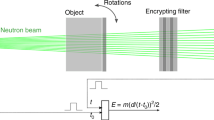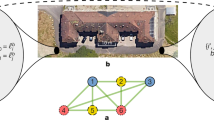Abstract
The verification of nuclear warheads for arms control involves a paradox: international inspectors will have to gain high confidence in the authenticity of submitted items while learning nothing about them. Proposed inspection systems featuring ‘information barriers’, designed to hide measurements stored in electronic systems, are at risk of tampering and snooping. Here we show the viability of a fundamentally new approach to nuclear warhead verification that incorporates a zero-knowledge protocol, which is designed in such a way that sensitive information is never measured and so does not need to be hidden. We interrogate submitted items with energetic neutrons, making, in effect, differential measurements of both neutron transmission and emission. Calculations for scenarios in which material is diverted from a test object show that a high degree of discrimination can be achieved while revealing zero information. Our ideas for a physical zero-knowledge system could have applications beyond the context of nuclear disarmament. The proposed technique suggests a way to perform comparisons or computations on personal or confidential data without measuring the data in the first place.
This is a preview of subscription content, access via your institution
Access options
Subscribe to this journal
Receive 51 print issues and online access
$199.00 per year
only $3.90 per issue
Buy this article
- Purchase on Springer Link
- Instant access to full article PDF
Prices may be subject to local taxes which are calculated during checkout




Similar content being viewed by others
References
Comley, C. et al. Confidence, Security & Verification: The Challenge of Global Nuclear Weapons Arms Controlhttp://www.fissilematerials.org/library/awe00.pdf (Atomic Weapons Establishment, Aldermaston, UK, 2000)
Spears D., ed. Technology R&D for Arms Controlhttp://www.fissilematerials.org/library/doe01b.pdf (US Department of Energy, Office of Nonproliferation Research and Engineering, Washington DC, 2001)
Fuller, J. in Cultivating Confidence: Verification, Monitoring, and Enforcement for a World Free of Nuclear Weapons (ed. Hinderstein, C. ) Ch. 4 (Hoover Institution Press, 2010)
Anderson, B. et al. Verification of Nuclear Weapon Dismantlement: Peer Review of the UK MoD Programme (British Pugwash Group, London, 2012)
Goldwasser, S., Micali, S. & Rackoff, C. The knowledge complexity of interactive proof-systems. SIAM J. Comput. 18, 186–208 (1989)
Chazelle, B. The security of knowing nothing. Nature 446, 992–993 (2007)
Fuller, J. Verification on the road to zero: issues for nuclear warhead dismantlement. Arms Control Today 40 (10). 19–27 (December 2010)
A general Monte Carlo N-particle (MCNP) transport code. Release MCNP5-1.40 http://mcnp.lanl.gov (Los Alamos National Laboratory, 2005)
Roquemore, A. L., Jassby, D. L., Johnson, L. C., Strachan, J. D. & Barnes, C. W. Performance of a 14-MeV neutron generator as an in situ calibration source for TFTR. In 15th IEEE/NPSS Symposium on Fusion Engineering 114–118 (IEEE, 1993)
Hall, J. Uncovering hidden defects with neutrons. Sci. Technol. Rev. http://www.llnl.gov/str/May01/Hall.html 4–11 (May 2001)
d’Errico, F. Radiation dosimetry and spectrometry with superheated emulsions. Nucl. Instrum. Methods Phys. Res. B 184, 229–254 (2001)
d’Errico, F., Nath, R., Lamba, M. & Holland, S. K. A position sensitive superheated emulsion chamber for three-dimensional photon dosimetry. Phys. Med. Biol. 43, 1147–1158 (1998)
d’Errico, F., Di Fulvio, A., Maryañski, M., Selici, S. & Torrigiani, M. Optical readout of superheated emulsions. Radiat. Meas. 43, 432–436 (2008)
Bleuel, D. L. et al. Neutron activation analysis at the National Ignition Facility. Rev. Sci. Instrum. 83, 10D313 (2012)
Thermo Scientific P 385 Neutron Generator. http://www.thermoscientific.com/en/product/p-385-neutron-generator.html
Allen, K. et al. UK-Norway Initiative (UKNI) approach for the development of a gamma ray attribute measurement system with an integrated information barrier. In Proc. ESARDA 35th Annual Meeting (Ispra, Italy, June 2013) (ed. Sevini, F. ) (European Commission, 2013)
Goldreich, O., Micali, S. & Wigderson, A. in Proc. 19th Annual ACM Conference on Theory of Computing (ed. Aho, A. V. ) 218–229 (ACM Press, 1987)
Lindell, Y. & Pinkas, B. Secure multiparty computation for privacy-preserving data mining. J. Privacy Confident. 1, 59–98 (2009)
Fisch, B., Freund, D. & Naor, M. Physical zero-knowledge proofs of physical properties. In Proceedings of CRYPTO 2014 (eds Garay, J. & Gennaro, R. ) (in the press); http://www.iacr.org/conferences/crypto2014/acceptedpapers.html
Acknowledgements
This project was supported by Global Zero and the US Department of State, the Princeton Plasma Physics Laboratory (DOE contract DE-AC02-09CH11466) and in-kind contributions from Microsoft Research New England. We thank D. Dobkin, F. d’Errico, J. Fuller, D. MacArthur, J. Mihalczo, S. Philippe and M. Walker for discussions and feedback. We thank S. Philippe (Princeton University) for graphics in Fig. 2. All simulations were run on Princeton University’s High Performance Cluster.
Author information
Authors and Affiliations
Contributions
A.G. was project leader and performed all of the MCNP5 calculations. B.B. and R.J.G. contributed, along with A.G., to developing the overall approach and the application of zero-knowledge proofs to warhead verification.
Corresponding author
Ethics declarations
Competing interests
The authors declare no competing financial interests.
Rights and permissions
About this article
Cite this article
Glaser, A., Barak, B. & Goldston, R. A zero-knowledge protocol for nuclear warhead verification. Nature 510, 497–502 (2014). https://doi.org/10.1038/nature13457
Received:
Accepted:
Published:
Issue Date:
DOI: https://doi.org/10.1038/nature13457
This article is cited by
-
Homomorphic inference of deep neural networks for zero-knowledge verification of nuclear warheads
Scientific Reports (2023)
-
Nuclear resonance fluorescence drug inspection
Scientific Reports (2021)
-
Experimental relativistic zero-knowledge proofs
Nature (2021)
-
Card-Based Cryptography Meets Formal Verification
New Generation Computing (2021)
-
A physical unclonable neutron sensor for nuclear arms control inspections
Scientific Reports (2020)
Comments
By submitting a comment you agree to abide by our Terms and Community Guidelines. If you find something abusive or that does not comply with our terms or guidelines please flag it as inappropriate.



